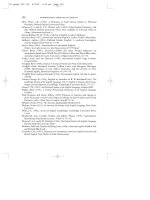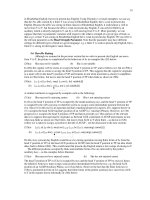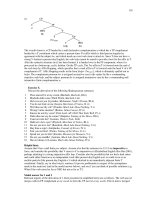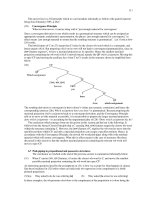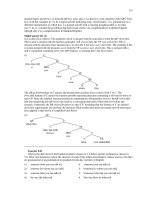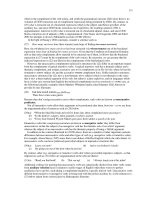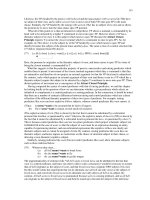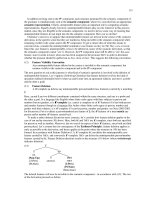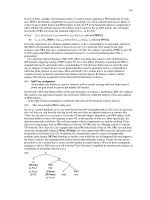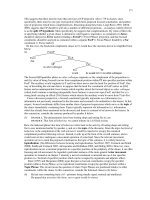Cú pháp tiếng anh part 15 ppsx
Bạn đang xem bản rút gọn của tài liệu. Xem và tải ngay bản đầy đủ của tài liệu tại đây (99.46 KB, 10 trang )
141
Likewise, the VPs headed by the passive verb believed and the unaccusative verb occurred in (76b) have
no subject of their own, and so allow several riots to move out of both VPs into spec-TP in the main
clause. Similarly, the VP headed by the raising verb seem in (76c) has no subject of its own and so allows
the pronoun he to move into the main clause spec-TP position.
What all of this points to is that an intransitive (subjectless) VP allows a nominal c-commanded by its
head verb to be attracted by a higher T constituent to move into spec-TP. However where a VP has a
thematic subject of its own, it is this subject which raises to spec-TP (because the Attract Closest
Principle requires T to attract the closest nominal which it c-commands to raise to spec-TP). So, for
example, in (76c) above, it is the subject he of the VP headed by scare which raises to spec-TP and
thereby becomes the subject of the present tense auxiliary does. The same is true of a control structure like
(77) below (repeated from (69) above):
(77) [
TP
He [
T
does] [
VP
he [
V
want] [
CP
[
C
ø] [
TP
[
T
to] [
VP
PRO [
V
scare] them]]]]]
Here, the pronoun he originates as the thematic subject of want, and hence raises to spec-TP by virtue of
being the closest nominal c-commanded by T.
What this suggests is that the particular property of passive, unaccusative and raising predicates which
enables them to permit A-movement of the closest nominal argument which they c-command is that they
are intransitive and therefore do not project an external argument (so that the VP they head is subjectless).
By contrast, verbs which project an external argument of their own (and hence occur in a VP which has a
thematic subject) require this subject to be attracted by a higher T constituent to move into spec-TP. These
distinct patterns of movement are a consequence of the Attract Closest Principle.
Having compared the syntax of control predicates with that of raising predicates, we end this chapter
by looking briefly at the question of how we can determine whether a given predicate which selects an
infinitival to complement is a control predicate or a raising predicate. In this connection, it should be noted
that there are a number of syntactic differences between raising and control predicates which are a direct
reflection of the different thematic properties of these two types of predicate. For example, raising
predicates like seem can have expletive it/there subjects, whereas control predicates like want cannot: cf.
(78)(a) It seems/*wants to be assumed that he lied to Congress
(b) There seem/*want to remain several unsolved mysteries
(The expletive nature of it in (78a) is shown by the fact that it cannot be substituted by a referential
pronoun like this/that, or questioned by what? Likewise, the expletive nature of there in (78b) is shown by
the fact that it cannot be substituted by a referential locative pronoun like here, or questioned by where?)
This is because control predicates like want are two-place predicates which project a thematic subject (an
EXPERIENCER in the case of want, so that the subject of want must be an expression denoting an entity
capable of experiencing desires), and non-referential expressions like expletive it/there are clearly not
thematic subjects and so cannot be assigned a θ-role. By contrast, raising predicates like seem have no
thematic subject, and hence impose no restrictions on the choice of structural subject in their clause, so
allowing a (non-thematic) expletive subject.
Similarly, raising predicates like seem (but not control predicates like want) allow idiomatic subjects
such as those italicised below:
(79) Whenever they meet,
(a) all hell seems/*wants to break loose
(b) the fur seems/*wants to fly
(c) the cat seems/*wants to get his tongue
The ungrammaticality of sentences like *All hell wants to break loose can be attributed to the fact that
want is a control predicate, and hence (in order to derive such a structure) it would be necessary to assume
that all hell originates as the subject of want, and that break loose has a separate PRO subject of its own:
but this would violate the requirement that (on its idiomatic use) all hell can only occur as the subject of
break loose, and conversely break loose (in its idiomatic use) only allows all hell as its subject. By
contrast, All hell seems to break loose is grammatical because seem is a raising predicate, and so all hell
can originate as the subject of break loose and then be raised up to become the subject of the null tense
142
constituent [
T
ø] in the seem clause.
A further property which differentiates the two types of predicate is that raising predicates like seem
preserve truth-functional equivalence under passivisation, so that (80a) below is cognitively synonymous
with (80b):
(80)(a) John seems to have helped Mary (b) =Mary seems to have been helped by John
By contrast, control predicates like want do not preserve truth functional equivalence under passivisation,
as we see from the fact that (81a) below is not cognitively synonymous with (81b):
(81)(a) John wants to help Mary (b) ≠Mary wants to be helped by John
Moreover, there are pragmatic restrictions on the choice of subject which control predicates like want
allow (in that the subject generally has to be a rational being, not an inanimate entity) – as we see from
(82) below (where ! marks pragmatic anomaly):
(82) My cat/!My gesture wants to be appreciated
By contrast, raising predicates freely allow animate or inanimate subjects: cf.
(83) My cat/My gesture seems to have been appreciated
The different properties of the two types of predicate stem from the fact that control predicates like want
θ-mark their subjects, whereas raising predicates like seem do not: so, since want selects an EXPERIENCER
subject as its external argument (and prototypical EXPERIENCERS are animate beings), want allows an
animate subject like my cat, but not an inanimate subject like my gesture. By contrast, since raising
predicates like seem do not θ-mark their subjects, they allow a free choice of subject.
A final remark to be made is that although our discussion of raising and control predicates has
revolved around verbs, a parallel distinction is found in adjectives. For example, in sentences such as:
(84)(a) John is likely to win the race (b) John is keen to win the race
the adjective likely is a raising predicate and keen a control predicate. We can see this from the fact that
likely allows expletive and idiomatic subjects, but keen does not: cf.
(85)(a) There is likely/*keen to be a strike (b) All hell is likely/*keen to break loose
This is one reason why throughout this chapter we have talked about different types of predicate (e.g.
drawing a distinction between raising and control predicates) rather than different types of verb.
7.10 Summary
This chapter has primarily been concerned with the syntax of subjects. In §7.2 we argued that
Belfast English structures such as There should some students get distinctions provide us with evidence
that subjects originate internally within VP, and we noted that the claim that subjects originate internally
within VP is known as the VP-Internal Subject Hypothesis/VPISH. We also maintained that sentences
such as Some students should get distinctions involve movement of some students from the specifier
position within VP to the specifier position within TP, and we noted that the relevant movement operation
is known as A-movement. In §7.3 we suggested that idioms like All hell will break loose provide further
empirical support for the VPISH, since the assumption that idioms are unitary constituents requires us to
suppose that all hell originates as a sister of break loose (in the specifier position within VP) and from
there is raised up (by application of A-movement) to become the specifier of the TP headed by will. In
§7.4 we argued that the VP-Internal Subject Hypothesis allows us to posit a uniform mapping between
thematic argument structure and (initial) syntactic structure, if we suppose that all arguments of a
predicate originate (and are theta-marked) internally within a projection of the predicate. In §7.5, we
looked at the syntax of unaccusative predicates like arise/remain/occur etc. and hypothesised that the
argument of an unaccusative verb originates as its complement but differs from the complement of a
transitive verb in that it has no subject, and receives nominative rather than accusative case. We
highlighted a number of further differences between unaccusative predicates and other types of predicate
(e.g. in relation to the position of subjects in Belfast English imperatives, and auxiliary selection in earlier
varieties of English). In §7.6, we looked at the structure of simple passive clauses, arguing that a passive
subject originates as the thematic complement of a subjectless passive participle, and is raised into spec-
143
TP (via A-movement) in order to satisfy the [EPP] feature of T. In §7.7 we saw that passivisation can be a
long distance operation involving movement of an argument contained within an infinitival TP which is
the complement of a passive participle. We noted that the position of idiomatic subjects in sentences like
Little heed is believed to have been paid to their proposal provides empirical support for positing long
distance passivisation (as a particular instance of a more general A-movement operation which attracts the
closest noun or pronoun expression c-commanded by T to move to spec-TP). In §7.9 we argued that
predicates like seem/appear function as raising predicates in the sense that their subjects originate
internally within their infinitive complement, and from there are raised to spec-TP position within the
seem/appear-clause: hence, in a sentence such as All hell would appear to have broken loose, the
idiomatic expression all hell originates as the subject of broken loose and from there is raised up to
become the subject of would by A-movement. In §7.10, we contrasted raising predicates with control
predicates, noting that they differ in that control predicates theta-mark their subjects (and hence generally
require an animate subject) and have a CP complement, whereas raising predicates do not theta-mark their
subjects (and hence freely allow inanimate, expletive and idiomatic subjects) and have a TP complement.
We also noted that (unlike control predicates), raising predicates preserve truth-functional equivalence
under passivisation.
WORKBOOK SECTION
Exercise XIII
Say whether the italicized verbs as used in the type of construction illustrated in the examples below
function as raising or control predicates (or are ambiguous and can serve as both), and what evidence there
is to support your analysis. Provide a detailed outline of the derivation of any one of the control sentences
and any one of the raising sentences, giving arguments in support of your answer.
1 Employers tend to exploit employees 2 John has decided to quit the university
3 We came to appreciate the classes 4 You have to help me
5 They failed to hit the target 6 He tried to rectify the situation
7 He refused to sign the petition 8 He’s beginning to irritate me
9 They attempted to pervert the course of justice 10 I happened to be passing your house
11 He is going to quit his job 12 He stands to lose a fortune
13 John promises to be a good student 14 He needs to have a shave
15 They managed to open the door 16 We intend to close the store
17 The weather is threatening to ruin the weekend 18 We are hoping to get a visa
19 She has chosen to ignore him 20 They are planning to visit London
Model answer for 1
There are a number of reasons for suggesting that tend functions as a raising predicate when it takes an
infinitive complement. For one thing (as we would expect if tend is a one-place raising predicate which
does not theta-mark its subject), tend imposes no restrictions on its choice of subject, and so freely allows
either an expression like Professor Peabrain (denoting an animate being) or an expression like Syntax
(denoting an inanimate entity) as the subject of its containing clause – as illustrated in (i) below:
(i) Professor Peabrain/Syntax tends to baffle people
Moreover, tend allows a nonthematic subject like expletive there/it – as in the examples below:
(ii) There tends to be a lot of confusion about syntax (iii) It tends to be assumed that syntax is hard
(We can tell that there is an expletive pronoun in (ii) from the fact that it cannot be substituted by here or
questioned by where? Likwise, it must be expletive in (iii) because it cannot be substituted by this/that or
questioned by what?) Moreover, tend can have an idiomatic subject, as in (iv) below:
(iv) All hell tends to break loose
Give that all hell can serve only as the subject of break loose in the relevant idiom in (iv), it is clear that
we could not analyse tend as a control predicate in (iv) and claim that all hell originates as the subject of
tend and PRO as the subject of break loose, since this would violate the requirement that all hell can occur
144
only as the subject of break loose and conversely that break loose can only have the subject all hell (in the
relevant idiom). By contrast, if tend is a raising predicate, we can claim that all hell originates as the
subject of break loose and then raises up to become the subject of the (null T constituent in the) tend
clause. Furthermore, tend preserves truth-functional equivalence under passivisation, as we can see from
the fact that (v) and (vi) are truth-functionally equivalent:
(v) Employers tend to exploit employees (vi) =Employees tend to be exploited by employers
Given the assumption that tend is a raising predicate, sentence 1 will be derived as follows. The noun
employees merges with a null determiner (which has much the same generic sense as the in The Italians
love pasta) to form the DP ø employees. The resulting DP merges with (and is assigned the q-role of
THEME argument of) the verb exploit to form the V-bar exploit ø employees. The DP ø employers (itself
formed by merging a null determiner with the noun employers) is then merged with (and assigned the
q-role of AGENT argument of) this V-bar, forming the VP ø employers exploit ø employees. This VP is
merged as the complement of the infinitival tense particle to, forming the TP to ø employers exploit ø
employees. The relevant TP is in turn merged with the verb tend, forming the VP tend to ø employers
exploit ø employees: we can perhaps take the TP complement of tend to have the thematic function of
being a THEME argument of tend. The resulting VP is merged with a null present tense T, forming [
T
ø]
tend to ø employers exploit ø employees. By virtue of being finite, [
T
ø] has an EPP feature requiring it to
have a specifier. In accordance with the Attract Closest Principle, this requirement is satisfied by moving
the closest nominal c-commanded by [
T
ø] – namely the DP ø employers – into spec-TP in the manner
shown by the dotted arrow below:
(vii) [
TP
ø employers [
T
ø] [
VP
[
V
tend] [
TP
[
T
to] [
VP
ø employers [
V
exploit] employees]]]]
The resulting structure (vii) is merged with a null complementiser marking the declarative force of the
sentence, so forming the structure (vii) below:
(viii) [
CP
[
C
ø] [
TP
ø employers [
T
ø] [
VP
[
V
tend] [
TP
[
T
to] [
VP
ø employers [
V
exploit] employees]]]]]
The derivation satisfies the q-criterion by virtue of the fact that each argument carrries one and only one
q-role: i.e. ø employees is the THEME argument of exploit, ø employers is the AGENT argument of exploit
and the TP complement of tend is its THEME argument.
_____________________________________________________________________________________
Exercise XIV
Discuss the derivation of the following sentences:
1a There are certain to remain some problems
b There were reported to remain some problems
c There were thought likely to remain some problems
2a A change of policy was envisaged
b A change of policy seems to be envisaged
c A change of policy is thought likely to be envisaged
3a Differences of opinion are emerging
b Differences of opinion are beginning to emerge
c Differences of opinion appear to be starting to emerge
4a He is leaving the country
b He is planning to leave the country
c He is thought to be planning to leave the country
5a No details are going to be revealed
b No details of any threats seem likely to be revealed
c No details are expected to be revealed of any threats
Helpful hints
145
Assume that the infinitive form be is an auxiliary occupying the head AUX position of AUXP when
immediately followed by a passive or progressive participle. For the purposes of this exercise, assume that
a finite T has an [EPP] feature, but that infinitival to does not. Assume that he has the thematic role of an
EXPERIENCER argument of the relevant predicates in 4, but that all other arguments in 1-5 are THEME
arguments of their associated predicates. In relation to 5a, consider the significance of the fact that going
to can contract to gonna; in 5b/c assume that any is a partitive quantifier which has the property of being a
polarity item (in the sense specified in exercise 3.2), and so must be c-commanded by a negative or
interrogative constituent; in relation to 5c, bear in mind the discussion of discontinuous spellout in the
text.
Model answer for 1a
The quantifier some merges with the noun problems to form the QP some problems. This QP is merged
with (and assigned the q-role of THEME complement of) the unaccusative predicate remain to form the
VP remain some problems. This in turn is merged with the infinitival tense particle to, forming the TP to
remain some problems. This is then merged with the raising adjective certain to form the AP certain to
remain some problems. This in turn is merged with the copular verb be to form the VP be certain to
remain some problems. The resulting VP is merged with a null finite T which attracts the copula be to
move from V to T in the manner showed by the dotted arrow in (i), so forming the structure shown in
simplified form below:
(i) T '
T VP
be
V AP
be
A TP
certain
T VP
to
V QP
remain some problems
T (by virtue of being finite) has an [EPP] feature requiring it to project a subject, and this requirement is
satisfied by merging there in spec-TP, forming the structure shown in abbreviated form in (ii) below
(where t is a trace of the moved auxiliary be):
(ii) TP
PRN T '
there
T VP
are
V AP
t certain to remain some problems
The TP in (ii) is subsequently merged with a null declarative complementiser.
The analysis presented here assumes that certain is a raising adjective. Evidence that this is so comes
from the fact that clauses containing certain allow expletive and idiomatic subjects, as in:
(iii)(a) It is certain to be raining in Manchester
(b) The fur is certain to fly
The expletive nature of it in (iiia) is shown by the fact that it cannot be substituted by referential pronouns
like this/that or questioned by what?
_____________________________________________________________________________________
146
8.
Agreement, Case and Movement
8.1 Overview
In this chapter, we take a look at the syntax of agreement. We begin by outlining the claim
made by Chomsky in recent work that agreement involves a relation between a probe and a goal (though
it should be noted that the term goal in this chapter is used in an entirely different way from the term
GOAL which was used to denote the thematic role played by a particular kind of argument in relation to its
predicate in §7.4). We look at the nature of agreement, and go on to show that nominative and null case-
marking involve agreement with T. Finally, we explore the relationship between the [EPP] feature carried
by T and agreement, and look at the consequences of this for control infinitives on the one hand and
raising infinitives on the other.
8.2 Agreement
In traditional grammars, finite auxiliaries are said to agree with their subjects. Since (within the
framework used here) finite auxiliaries occupy the head T position of TP and their subjects are in
spec-TP, in earlier work agreement was said to involve a specifier-head relationship (between T and its
specifier). However, there are both theoretical and empirical reasons for doubting that agreement involves
a spec-head relation. From a theoretical perspective (as we saw in §4.9), Minimalist considerations lead us
to the conclusion that we should restrict the range of syntactic relations used in linguistic description,
perhaps limiting them to the relation c-command created by merger. From a descriptive perspective, a
spec-head account of agreement is problematic in that it fails to account for agreement between the
auxiliary are and the nominal several prizes in passive structures such as:
(1) There are thought likely to be awarded several prizes
Since the auxiliary are occupies the head T position of TP in (1) and the expletive pronoun there is in
spec-TP, a spec-head account of agreement would lead us to expect that are should agree with there. But
instead, are agrees with the in situ complement several prizes of the passive participle awarded. What is
going on here? In order to try and understand this, let’s take a closer look at the derivation of (1).
The quantifier several merges with the noun prizes to form the QP several prizes. This is merged as
the thematic complement of the passive verb awarded to form the VP awarded several prizes. This in turn
is merged with the passive auxiliary be to form the AUXP be awarded several prizes. This is then merged
with the infinitival tense particle to, forming the TP to be awarded several prizes. The resulting TP is
merged with the raising adjective likely to derive the AP likely to be awarded several prizes. This AP is
subsequently merged with the passive verb thought to form the VP thought likely to be awarded several
prizes. This in turn merges with the passive auxiliary be, forming the T-bar shown in simplified form in
(2) below (where the notation BE indicates that the morphological form of the relevant item hasn’t yet
been determined)
147
(2) T '
T VP
BE
V AP
thought
A TP
likely
T AUXP
to
AUX VP
be
V QP
awarded several prizes
The tense auxiliary [
T
BE] needs to agree with an appropriate nominal within the structure containing it.
Given Pesetsky’s Earliness Principle (which requires operations to apply as early as possible in a
derivation), T-agreement must apply as early as possible in the derivation, and hence will apply as soon as
BE is introduced into the structure. On the assumption that c-command is central to syntactic operations, T
will agree with a nominal (i.e. a noun or pronoun expression) which it c-commands. Accordingly, as soon
as the structure in (2) is formed, [
T
BE] searches for a nominal which it c-commands to agree with.
To use the terminology introduced by Chomsky (1998, 1999, 2001), by virtue of being the highest
head in the overall structure at this point in the derivation, BE serves as a probe which searches for a
c-commanded nominal goal to agree with. The only nominal goal c-commanded by [
T
BE] within the
structure in (2) is the QP several prizes: [
T
BE] therefore agrees in person and number with several prizes,
and so is ultimately spelled out as the third person plural form are in the PF component. Chomsky refers
to person and number features together as f-features (where f is the Greek letter phi, pronounced in the
same way as fie in English): using this terminology, we can say that the probe [
T
BE] agrees in f-features
with the goal several prizes. Subsequently, expletive there is merged in spec-TP to satisfy the [EPP]
requirement for T to project a specifier, and the resulting TP is in turn merged with a null declarative
complementiser to form the CP shown in simplified form below (which is the structure of (1) above):
(3) [
CP
[
C
ø] [
TP
There [
T
are] [
VP
[
V
thought] [
AP
[
A
likely] [
TP
to be awarded several prizes]]]]]
However, there are a number of details which we have omitted in (3); one relates to the case assigned
to the complement (several prizes) of the passive participle awarded. Although case is not overtly marked
on the relevant noun expressions in English, evidence from languages like Icelandic with a richer case
system suggests that the complement of a passive participle in finite expletive clauses is assigned
nominative case via agreement with T – as the following contrast (from Sigurðsson 1996, p.12) illustrates:
(4)(a) Þad voru lesnar fjórar bækur
There were read four
NOM.PL
books
NOM.PL
(b) Þad var skilað fjórum bókum
There was returned four
DAT.PL
books
DAT.PL
In (4a), the auxiliary voru is a third person plural form which agrees with the NOM.PL/nominative plural
complement fjórar bækur ‘four books’. In (4b), the auxiliary is in the agreementless form var ‘was’, and
the complement of the passive participle is DAT.PL/dative plural. (Var is a third person singular form, but
can be treated as an agreementless form if we characterise agreement by saying that ‘An auxiliary is
first/second person if it agrees with a first/second person subject, but third person otherwise; it is plural if
it agrees with a plural subject, but singular otherwise.’ This means that a third person singular auxiliary
can arise either by agreement with a third person singular expression or – as here – can be a default form
used as a fall-back when the auxiliary doesn’t agree with anything.) Sigurðsson argues that it is an
inherent lexical property of the participle skilað ‘returned’ that (like around a quarter of transitive verbs in
148
Icelandic) it assigns so-called inherent dative case to its complement (See Svenonius 2002a/b on dative
complements), and (because it can’t agree with a non-nominative complement) the auxiliary surfaces in
the agreementless form var in (4b); by contrast, the participle lesnar ‘read’ in (4a) does not assign inherent
case to its complement, and instead the complement is assigned (so-called) structural nominative case via
agreement with the past Tense auxiliary voru ‘were’.
Icelandic data like (4) suggest that there is a systematic relationship between nominative case
assignment and T-agreement: they are two different reflexes of an agreement relationship between a finite
T probe and a nominal goal. In consequence of the agreement relationship between the two, the T probe
agrees with a nominal goal which it c-commands, and the nominal goal is assigned nominative case.
Accordingly, several prizes in (3) receives nominative case via agreement with [
T
are]. (It should be noted
in passing that throughout this chapter, we focus on characterising syntactic agreement. On so-called
‘semantic agreement’ in British English structures like The government are ruining the country, see den
Dikken 2001, and Sauerland and Elbourne 2002.)
The approach to case assignment outlined here (in which subjects are assigned nominative case via
agreement with a finite T) is different from that outlined in §4.9, where we suggested that subjects are
case-marked by a c-commanding C constituent. But in one sense, our revised hypothesis that finite
subjects are case-marked by T is consistent with our earlier analysis. In chapter 4, we argued that (in
consequence of the Earliness Principle) a noun or pronoun expression is case-marked by the closest
case-assigner which c-commands it: since we also assumed in chapter 4 that subjects originate in spec-TP,
it was natural to assume that they are case-marked by the closest functional head above them, namely C.
But once we move to an analysis like that in chapter 7 in which subjects originate internally within VP,
our assumption that they are case-marked by the closest case-assigning head above them opens up the
possibility that nominative subjects may be case-marked by T rather than by C – and indeed this is the
assumption which we will make from now on (an assumption widely made in current research).
8.3 Feature Valuation
Let’s think through rather more carefully what it means to say that case is systematically related
to agreement, and what the mechanism is by which case and agreement operate. To illustrate our
discussion, consider the derivation of a simple passive such as that produced by speaker B below:
(5) SPEAKER A: What happened to the protestors? SPEAKER B: They were arrested
Here, discourse factors determine that a third person plural pronoun is required in order to refer back to
the third person plural expression the protestors, and that a past tense auxiliary is required because the
event described took place in the past. So (as it were) the person/number features of they and the past tense
feature of were are determined in advance, before the items enter the derivation. By contrast the case
feature assigned to they and the person/number features assigned to were are determined via an agreement
operation in the course of the derivation: e.g. if the subject had been the singular pronoun one, the
auxiliary would have been third person singular via agreement with one (as in One was arrested); and if
THEY had been used as the object of a transitive verb (as in The police arrested them), it would have
surfaced in the accusative form them rather than the nominative form they.
Generalising at this point, let’s suppose that noun and pronoun expressions like THEY enter the syntax
with their (person and number) f-features already valued, but their case feature as yet unvalued. (The
notation THEY is used here to provide a case-independent characterisation of the word which is variously
spelled out as they/them/their depending on the case assigned to it in the syntax.) Using a transparent
feature notation, let’s say that THEY enters the derivation carrying the features [3-Pers, Pl-Num, u-Case],
where Pers = person, Pl = plural, Num = number, and u = unvalued). Similarly, let’s suppose that finite T
constituents (like the tense auxiliary BE) enter the derivation with their tense feature already valued, but
their person and number f-features as yet unvalued (because they are going to be valued via agreement
with a nominal goal). This means that BE enters the derivation carrying the features [Past-Tns, u-Pers,
u-Num]. In the light of these assumptions, let’s see how the derivation of (5B) proceeds.
The pronoun THEY is the thematic complement of the passive verb arrested and so merges with it to
form the VP arrested THEY. This is in turn merged with the tense auxiliary BE, forming the structure (6)
below (where already-valued features are shown in bold, and unvalued features in italics):
149
(6) T '
T VP
BE
[Past-Tns] V PRN
[u-Pers] arrested THEY
[u-Num] [3-Pers]
[Pl-Num]
[u-Case]
Given Pesetsky’s Earliness Principle, T-agreement will apply at this point. Let’s suppose that agreement
in such structures involves a c-command relation between a probe and a goal in which unvalued f-
features on the probe are valued by the goal, and an unvalued case-feature on the goal is valued by the
probe. (In Chomsky’s use of these terms, it is the unvalued person/number features which serve as the
probe rather than the item BE itself, but this is a distinction which we shall overlook throughout, in order
to simplify exposition.) Since [
T
BE] is the highest head in the structure (6), it serves as a probe which
searches for a c-commanded goal with an unvalued case feature, and locates the pronoun THEY.
Accordingly, an agreement relation is established between the probe BE and the goal THEY. One reflex of
this agreement relation is that the unvalued person and number features carried by the probe BE are valued
by the goal THEY. Valuation here involves a Feature Copying operation which we can sketch in general
terms as follows (where a and ß are two different constituents contained within the same structure, and
where one is a probe and the other a goal):
(7) Feature Copying
If α is valued for some feature [F] and β is unvalued for [F] and if β agrees with α, the feature-value
for [F] on a is copied onto ß
In consequence of the Feature Copying operation (7), the values of the person/number features of THEY
are copied onto BE, so that the unvalued person and number features [u-Pers, u-Num] on BE in (6) are
assigned the [3-Pers, Pl-Num] values carried by THEY – as shown in (8) below, where the underlined
features are those which have been valued via the Feature Copying operation (7):
(8) T '
T VP
BE
[Past-Tns] V PRN
[3-Pers] arrested THEY
[Pl-Num] [3-Pers]
[Pl-Num]
[u-Case]
A second reflex of the agreement relation between BE and THEY is that the unvalued case feature [u-Case]
carried by the goal THEY is valued by the probe BE. Since only auxiliaries with finite (present/past) tense
have nominative subjects (and not e.g. infinitival auxiliaries), we can suppose that it is the finite tense
features of the probe which are responsible for assigning nominative case to the goal. Accordingly, we can
posit that nominative case assignment involves the kind of operation sketched informally below:
(9) Nominative Case Assignment
An unvalued case feature on a goal is valued as nominative by a probe carrying finite tense if probe
and goal match in f-features (i.e. in person and number)
Since the person/number features of the probe BE match those of the goal THEY in (8), and since BE carries
finite tense (by virtue of its [Past-Tns] feature), the unvalued case feature on THEY is valued as
150
nominative, resulting in the structure shown in (10) below (where the underlined feature is the one valued
as nominative in accordance with (9) above):
(10) T '
T VP
BE
[Past-Tns] V PRN
[3-Pers] arrested THEY
[Pl-Num] [3-Pers]
[Pl-Num]
[Nom-Case]
Since all the features carried by BE are now valued, BE can ultimately be spelled out in the phonology as
the third person plural past tense form were. Likewise, since all the features carried by THEY are also
valued, THEY can ultimately be spelled out as the third person plural nominative form they. However, the
derivation in (8) is not yet terminated: the [EPP] feature of T will subsequently trigger A-movement of they
to become the structural subject of were, and the resulting TP they were arrested they will then be merged
with a null declarative complementiser to form the structure ø they were arrested they: but since our
immediate concern is with case and agreement, we skip over these details here.
8.4 Uninterpretable features and feature-deletion
Our discussion of how case and agreement work in a sentence such as (5B) has wider
implications. One of these is that items may enter the derivation with some of their features already
valued and others as yet unvalued: e.g. BE enters the derivation in (6) with its tense feature valued, but its
(person and number) f-features unvalued; and THEY enters with its f-features valued but its case feature
unvalued. This raises the question of which features are initially valued when they first enter the
derivation, which are initially unvalued – and why. Chomsky (1998) argues that the difference between
valued and unvalued grammatical features correlates with a further distinction between those grammatical
features which are interpretable (in the sense that they play a role in semantic interpretation), and those
which are uninterpretable (and hence play no role in semantic interpretation). For example, it seems
clear that the case feature of a pronoun like THEY is uninterpretable, since a subject pronoun surfaces as
nominative, accusative or genitive depending on the type of [bracketed] clause it is in, without any effect
on meaning – as the examples in (11) below illustrate:
(11)(a) It is said [they were arrested]
(b) He expected [them to be arrested]
(c) He was shocked at [their being arrested]
By contrast, the (person/number) f-features of pronouns are interpretable, since e.g. a first person
singular pronoun like I clearly differs in meaning from a third person plural pronoun like they. In the case
of finite auxiliaries, it is clear that their tense features are interpretable, since a present-tense form like is
differs in meaning from a past tense form like was. By contrast, the (person/number) f-features of
auxiliaries are uninterpretable, in that they serve purely to mark agreement with a particular nominal.
As we saw in the simplified model of grammar which we presented in §1.3, each structure generated
by the syntactic component of the grammar is subsequently sent to the PF component of the grammar to
be spelled out (i.e. assigned a PF representation which provides a representation of its Phonetic Form).
If we assume that unvalued features are illegible to (and hence cannot be processed by) the PF
component, it follows that every unvalued feature in a derivation must be valued in the course of the
derivation, or else the derivation will crash (i.e. fail) because the PF component is unable to spell out
unvalued features. In more concrete terms, this amounts to saying that unless the syntax specifies whether
we require e.g. a first person singular or third person plural present-tense form of BE, the derivation will
crash because the PF component cannot determine whether to spell out BE as am or are.
